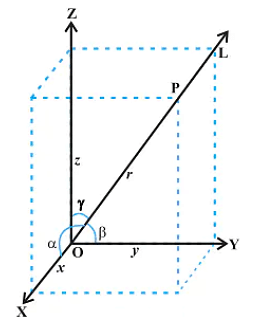Let Q be the cube with the set of vertices {(x1, x2, x3) ∈ R3: x1, x2, x3 ∈ {0,1}}. Let F be the set of all twelve lines containing the diagonals of the six faces of cube Q. Let S be the set of all four lines containing the main diagonals of the cube Q; for instance, the line passing through the vertices (0,0,0) and (1,1,1) is in S. For lines l1 and l2, let d(l1,l2) denote the shortest distance between them. Then the maximum value of d(l1,l2) as l1 varies over f and l2 varies over S, is
Let Q be the cube with the set of vertices {(x1, x2, x3) ∈ R3: x1, x2, x3 ∈ {0,1}}. Let F be the set of all twelve lines containing the diagonals of the six faces of cube Q. Let S be the set of all four lines containing the main diagonals of the cube Q; for instance, the line passing through the vertices (0,0,0) and (1,1,1) is in S. For lines l1 and l2, let d(l1,l2) denote the shortest distance between them. Then the maximum value of d(l1,l2) as l1 varies over f and l2 varies over S, is
- \(\frac{1}{\sqrt6}\)
- \(\frac{1}{\sqrt8}\)
- \(\frac{1}{\sqrt3}\)
- \(\frac{1}{\sqrt{12}}\)
The Correct Option is A
Solution and Explanation
The correct option is (A):
The equation of the OD line is
\(\vec{r_1}=\vec{0}+\lambda(\hat{i}+\hat{j})\)
equation of diagonal BE is
\(\vec{r_1}=\hat{j}+\alpha(\hat{i}-\hat{j}+\hat{k})\)
S.D = \(\left | \frac{\hat{j}.(\hat{i}-\hat{j}+\hat{k})}{\sqrt{6}} \right |=\frac{1}{\sqrt6}\)
Top Questions on introduction to three dimensional geometry
- If the 4th, 10th, and 16th terms of a G.P. are \(x\), \(y\), and \(z\) respectively, then
- KCET - 2025
- Mathematics
- introduction to three dimensional geometry
- The number of diagonals that can be drawn in an octagon is:
- KCET - 2025
- Mathematics
- introduction to three dimensional geometry
- The equation of the line through the point \( (0, 1, 2) \) and perpendicular to the line \[ \frac{x - 1}{2} = \frac{y + 1}{3} = \frac{z - 1}{-2} \] is:
- KCET - 2025
- Mathematics
- introduction to three dimensional geometry
- Let \( \vec{a}, \vec{b}, \vec{c} \) be three vectors. The angle between \( \vec{a} \) and \( \vec{b} \) is \( 30^\circ \), the angle between \( \vec{a} \) and \( \vec{b} + \vec{c} \) is \( 45^\circ \). If \( |\vec{b}| = \sqrt{6} \) and \( |\vec{c}| = 2\sqrt{2} \), then \( |\vec{b} + \vec{c}| \) is:
- KEAM - 2024
- Mathematics
- introduction to three dimensional geometry
- Let \[ f(x) = \frac{|5 - x|(x + 5)}{\tan(x - 5)} \quad {for} \quad x \neq 5. \] Then \[ \lim_{x \to 5} f(x) { is equal to:} \]
- KEAM - 2024
- Mathematics
- introduction to three dimensional geometry
Questions Asked in JEE Advanced exam
The reaction sequence given below is carried out with 16 moles of X. The yield of the major product in each step is given below the product in parentheses. The amount (in grams) of S produced is ____.

Use: Atomic mass (in amu): H = 1, C = 12, O = 16, Br = 80- JEE Advanced - 2025
- Organic Chemistry
Let $ a_0, a_1, ..., a_{23} $ be real numbers such that $$ \left(1 + \frac{2}{5}x \right)^{23} = \sum_{i=0}^{23} a_i x^i $$ for every real number $ x $. Let $ a_r $ be the largest among the numbers $ a_j $ for $ 0 \leq j \leq 23 $. Then the value of $ r $ is ________.
- JEE Advanced - 2025
- binomial expansion formula
- The total number of real solutions of the equation $$ \theta = \tan^{-1}(2 \tan \theta) - \frac{1}{2} \sin^{-1} \left( \frac{6 \tan \theta}{9 + \tan^2 \theta} \right) $$ is
(Here, the inverse trigonometric functions $ \sin^{-1} x $ and $ \tan^{-1} x $ assume values in $[-\frac{\pi}{2}, \frac{\pi}{2}]$ and $(-\frac{\pi}{2}, \frac{\pi}{2})$, respectively.)- JEE Advanced - 2025
- Inverse Trigonometric Functions
Let $ \mathbb{R} $ denote the set of all real numbers. Then the area of the region $$ \left\{ (x, y) \in \mathbb{R} \times \mathbb{R} : x > 0, y > \frac{1}{x},\ 5x - 4y - 1 > 0,\ 4x + 4y - 17 < 0 \right\} $$ is
- JEE Advanced - 2025
- Coordinate Geometry
The center of a disk of radius $ r $ and mass $ m $ is attached to a spring of spring constant $ k $, inside a ring of radius $ R>r $ as shown in the figure. The other end of the spring is attached on the periphery of the ring. Both the ring and the disk are in the same vertical plane. The disk can only roll along the inside periphery of the ring, without slipping. The spring can only be stretched or compressed along the periphery of the ring, following Hooke’s law. In equilibrium, the disk is at the bottom of the ring. Assuming small displacement of the disc, the time period of oscillation of center of mass of the disk is written as $ T = \frac{2\pi}{\omega} $. The correct expression for $ \omega $ is ( $ g $ is the acceleration due to gravity):

- JEE Advanced - 2025
- Waves and Oscillations
Concepts Used:
Three Dimensional Geometry
Mathematically, Geometry is one of the most important topics. The concepts of Geometry are derived w.r.t. the planes. So, Geometry is divided into three major categories based on its dimensions which are one-dimensional geometry, two-dimensional geometry, and three-dimensional geometry.
Direction Cosines and Direction Ratios of Line:
Consider a line L that is passing through the three-dimensional plane. Now, x,y and z are the axes of the plane and α,β, and γ are the three angles the line makes with these axes. These are commonly known as the direction angles of the plane. So, appropriately, we can say that cosα, cosβ, and cosγ are the direction cosines of the given line L.
